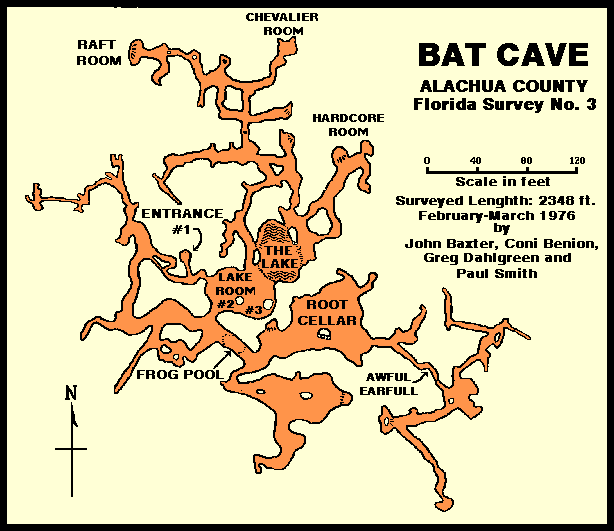GENERAL
How to be a Good Guest
Where is Bat Cave?
The AREA
Area rock Layers
Topography
Geomorphology
Geological History
The Paleozoic
The Mesozoic
The Cenozoic
Water
The Hydrologic Cycle
Solution
Solution chemistry
Karst Landscapes
Erosional Features
Depositional Features
Environmental Issues
BAT CAVE
How was Bat Cave formed?
Surface Plan of the site
Map of the Cave
Life in and around Bat Cave
A Virtual Trip Through Bat Cave
TEST YOUR KNOWLEDGE
 BAT CAVE: A General Introduction
BAT CAVE: A General Introduction
Bat Cave is, of course, a cave, one of the common features found in areas dominated by karst processes. There are over 150 such caves throughout Alachua County. Many, if not most of them, are below the water table and are therefore filled with water. Bat Cave was originally owned by Jefferson Smurfit Corp., a paper company based in Illinois, which transferred ownership to Santa Fe College in 1994. Since that time, SFC has fenced off the five entrances to the cave, removed 2 tractor trailers full of garbage from the cave and surrounding area, and cleaned the graffiti from the cave walls. The cave is now an educational facility.
In reality, a cave is a naturally formed underground open area or chamber, or series of chambers large enough for people to enter. The term cave is often used interchangeably with cavern. Carverns are usually thought of as large systems of caves or a series of large chambers within a cave. Some caves are small, while others include enormous chambers, hundreds or even thousands of feet wide and high. Many caves are shallow but some cavern systems may extend down to more than a mile below the surface.
What kind of Cave is Bat Cave?
The karst features at Bat Cave formed slowly and gradually as the joints in the limestone were enlarged by solution. In some places in the cave, the rocks did settle and collapse. In several places, the cover material washed into the cavern along the enlarged joints and the solution pipes in a process called raveling. Usually, a change in the water elevations in the aquifer leads to raveling. In the case of Bat Cave, most likely an episode of drought led to a lowering of the water table, and, once the solution pipes and the enlarged joints became connected to the cavities in the limestone below the water table, the loose surface materials, mostly sands, began to infill the caverns.
What does Bat Cave look like?
This is a plan view of Bat cave made by the Florida Speleological Society.
